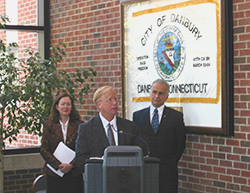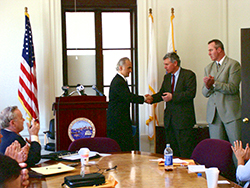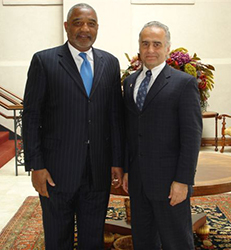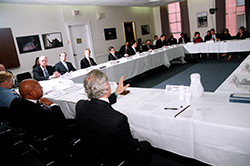 |
IN
THE NEWS |
 |
| |
RESOURCES
TO NOTE |
|
|
 |
|
|
May 10. The United States Interagency Council on Homelessness will hold
The National Summit for Jurisdictional Leaders:
Moving From Good to Better to Great in Sustaining 10-Year Plans to
End Chronic Homelessness May 10-12 in Denver, Colorado. The summit will bring together jurisdictional
leaders involved in developing 10-Year plans, innovative thinkers,
and practitioners to highlight and advance innovative strategies
from cities, counties, regions, and states across the country that
are producing results.
The
agenda includes a keynote address by Jim Collins, best selling author
of Good to Great and Built to Last, peer to peer Discovery and Dialogue
Sessions, and an awards luncheon. Mr. Collins will discuss how good
performers become great performers and what can cause good performers
to slide into mediocrity. The awards luncheon on May 11 will include
presentations of “A Home for Every American Award” recognizing
outstanding partnership, political will, innovation, and results in
ending chronic homelessness. On Friday, summit attendees will have an
opportunity to attend a special Denver 10-Year Plan Showcase, which
will include learning sessions and site tours of Denver’s innovative
practices and programs.
 Denver is a particularly appropriate choice as the site for this summit
since all the elements of a successful 10-Year Plan effort are in evidence:
political will, broad partnership, a housing-centered plan, and a focus
on results. Denver Mayor John Hickenlooper was one of the first jurisdictional
leaders in the country to commit to developing a 10-Year Plan and has been
outspoken in his support of creating supportive housing opportunities for
persons experiencing chronic homelessness, including testifying in 2004
at a hearing of the House Financial Services Committee on the Administration’s
Samaritan Initiative. Denver is a particularly appropriate choice as the site for this summit
since all the elements of a successful 10-Year Plan effort are in evidence:
political will, broad partnership, a housing-centered plan, and a focus
on results. Denver Mayor John Hickenlooper was one of the first jurisdictional
leaders in the country to commit to developing a 10-Year Plan and has been
outspoken in his support of creating supportive housing opportunities for
persons experiencing chronic homelessness, including testifying in 2004
at a hearing of the House Financial Services Committee on the Administration’s
Samaritan Initiative.
The 41-member Denver Commission to End Homelessness appointed by Mayor
Hickenlooper to develop a 10-Year Plan, included representation from a broad
stakeholder group of government and business leaders, providers, funders,
consumers, neighborhoods and faith based organizations. The resulting plan,
Denver’s Road Home, released in May of last year, calls for creating
over 3100 new permanent housing opportunities for Denver’s homeless
population, including 942 permanent supportive housing units for persons
experiencing chronic homelessness. The plan sets a goal to reduce chronic
homelessness by 75% over five years. Roxanne White, manager of Denver’s
Department of Human Services, chaired the successful Commission effort and
has been instrumental in moving the plan forward into implementation.
Results released this week from the most recent point-in-time survey done
in January of this year show an 11.5% drop in the number of homeless in
the Denver metropolitan region including a 4% drop in the city. A unique
characteristic of the Denver plan is the strength of its partnership with
the faith-based community, including the involvement of about 100 local
religious congregations.

TWO HISTORIC NEW ENGLAND COMMUNITIES READY TO MOVE TO IMPLEMENTATION PHASE OF
10-YEAR PLAN EFFORT
Danbury, CT.
Broad partnership was in evidence as Danbury, CT Mayor Mark Boughton
formally released the final report of the Mayor’s Task Force to End Homelessness at a press
conference at City Hall on May 1. The Task Force, chaired by Probate Judge Dianne
Yamin, was appointed by the mayor last year to develop a 10-Year plan to end
homelessness in Danbury. Mayor Boughton was joined at the press conference by
Judge Yamin and by Director of Welfare and Social Services Debbie MacKenzie.
In releasing the plan, Mayor Boughton announced his "intention to
direct the local resources necessary to implement the plan and to encourage
our government partners in Washington and Hartford to join us in this
endeavor."
One of those government partners in Washington, United States Interagency Council on
Homelessness Executive Director Philip Mangano, accompanied by Council Regional
Coordinator John O’Brien, joined Mayor Boughton at the press conference. Director
Mangano commended the mayor for his leadership and political will. "Today,
Mayor Boughton and Danbury join a national partnership that begins in the White
House and extends to the streets of our country partnering 20 federal agencies,
53 Governors including Connecticut Governor Jodi Rell and 216 mayors and country
executives through their 10 Year plans. Danbury’s realistic action plan is
housing centered, consumer informed, and prevention focused to create results that
will improve the quality of life for everyone in this great community."

Director Mangano noted that the inclusive and expansive group of
stakeholders who served on the Task Force -- including state representatives
Janice Geigler and Robert Godfrey, Paul O’Sullivan of Congresswoman
Nancy Johnson’s office,
and officials from hospitals, the United Way, business, developers,
banks, academia, mental health, substance abuse and other service providers,
the VA, homeless people, public safety officers, the courts, Habitat
for Humanity, the faith community -- would be the envy of many communities
across the country. Pictured here from left to right are Diane Yamin, Judge
of Probate, Danbury and Chair of the Mayor's Task Force to End Homelessness,
Mayor Boughton, and Director Mangano.
In the final report, the Task Force members write that Mayor Boughton’s charge
to them to create a comprehensive plan to end homelessness in 10 years "proved to
be a great opportunity on many fronts. The multidisciplinary representation allowed
the many understandings of homelessness and its solutions to be shared and considered.
The plan required examination of the institutional and philosophical beliefs that
were useful in managing homelessness but will not move us forward as we strive to
end it. The planning process has been cause to assess utilization of resources,
explore best practices, develop community-driven strategies and adopt a vision
for ending homelessness with stable permanent housing as the goal." You
can read more of the Danbury 10-Year Plan on the city website at
www.danbury-ct.gov
or by going to our website at
www.usich.gov.

NEW BEDFORD,
MA.
In the City of New Bedford, MA, where a memorial to Frederick
Douglass stands at City Hall honoring the renowned abolitionist
who found refuge in this historic "Whaling City" after
escaping slavery in Maryland, abolition of a different wrong -- homelessness
-- was on the minds of elected and community leaders last week.
At a news conference, New Bedford Mayor Scott W. Lang, joined
by members of the Mayor’s
Homeless Task Force, including Office of Housing and Community Development
Director Patrick Sullivan who served as the Task Force Chairman,
and by members of New Bedford’s Homeless
Service Providers Network, released the city’s 10-year plan to "end
episodic and chronic homelessness."

The New Bedford plan "articulates the city’s formal strategy for
assisting homeless individuals and families move from the streets and shelters
to economic independence and self sufficiency." Strategies discussed
in the plan include prevention, expansion of the permanent supportive housing,
increasing emergency shelter and transitional housing units, expanding employment
opportunities and improving access to mainstream resources for homeless individuals
and families. Mayor Lang noted that "the implementation of these strategies
can have a significant measurable impact on reducing the number of people
who are homeless in New Bedford, but not without the input, participation
and commitment from the greater New Bedford community." He added, "Every
individual and family faced with homelessness in New Bedford should have
access to safe, decent, and affordable housing along with the resources to
maintain it." Pictured here standing are Mayor Lang (center),
Patrick Sullivan, Director of the New Bedford Office of Housing and Community
Development (right), and Director Mangano (left).
United States Interagency Council on Homelessness Executive Director Philip Mangano
who was invited to address the partners at the press conference, applauded the Mayor
and those who worked on the plan for recognizing that the written plan "is the
beginning of the City’s efforts" and for including in the plan "the
call to get a broader and more expansive group of stakeholders to create the
implementation and action phases."
|
"Nothing is successful in terms of this issue of homelessness that
leaves homeless people where they are. A proven reduction in the number
of people living without a permanent home is the measure of success."
USICH Executive Director Philip Mangano
|
Director Mangano welcomed New Bedford "to the results-oriented National Partnership"
and added that, "Nothing is successful in terms of this issue of homelessness that
leaves homeless people where they are. A proven reduction in the number of people living
without a permanent home is the measure of success. Other cities that have developed 10 year
plans have seen decreases in their chronic homeless population including Quincy, MA which
has seen a 20% drop in its first year of implementation and Nashua, NH which has experienced
a 40% decline in the first year and a half of its 10 year plan implementation."
He encouraged the city to maximize its opportunities to apply for and receive resources,
such as through HUD’s permanent housing bonus, to create new permanent housing tenancies
beyond the 100 committed to in the plan. Director Mangano also acknowledged the presence
of a long time friend and champion of homeless people, Sister Rose Ellen Gallogly, Executive
Director of Market Ministries and a founding member of the New Bedford Homeless Service
Providers Network.
For More Information:
Patrick Sullivan, 10-Year Plan Task Force Chair and Director, New Bedford
Office of Housing and Community Development, 508-979-1500
John O’Brien, USICH Regional Coordinator, 617-994-8203

MACON AND BIBB COUNTY, GA TO PARTNER ON 10-YEAR PLAN
April 19, 2006.
Just a day after the tour de Georgia swept through the streets of this central
Georgia community, street concerns of a different sort were the focus of attention
when Macon Mayor C. Jack Elllis joined by nearly 50 other government and civic leaders,
police officers, and representatives of area charities met over breakfast at the
Mulberry Street United Methodist Church to announce plans to develop a 10-Year Plan
To End Chronic Homelessness.
The 10-year planning effort will be led by a Housing First Task Force, co-chaired
by Dr. Peter Brown, Associate Vice President and Director of the Mercer University
Center for Service Learning and Community Development, Sister Marian Hamwey of Mother
and Child Ministries, and Kevin Dubose, Director of Macon’s Department of Economic
and Community Development.

Speaking to the assembled group, USICH Executive Director Mangano praised Mayor
Ellis and Bibb County Commission Chairman Charlie Bishop for "acting in partnership
to collaborate on developing a plan that will mean that the quality of life for
everyone here in Bibb County and Macon—housed and homeless alike—will improve."
With a population of 155,000, "there are a lot more Bibb County/Macon’s in
our country than New York’s , LA’s or Chicago’s. You’ll
inspire all those other communities your size with your creativity and can-do attitude".
City estimates of the number of chronically homeless in Macon have varied from 200-400
in recent years.
Noting the community can count on receiving ongoing technical assistance from USICH,
whose Region 4 Coordinator Michael German was also present, Director Mangano urged
the community leaders to use their participation in this national partnership to
learn about and "borrow best practices from other communities to add to your own
innovative ideas" and to "create a results oriented plan shaped around the
Killer B’s —baselines, benchmarks, budget and best practices performance."

MEETING OF THE FULL COUNCIL HELD IN APRIL
Convened by HUD
Secretary Jackson as Council Chair, federal agencies review the status of Katrina
recovery efforts and progress in ending chronic homelessness nationally.
Council Executive
Director Mangano affirms Council’s commitment to achieving results:
tangible outcomes in the lives of homeless people

Ending Chronic Homelessness
Federal partners reported results in federal initiatives targeted to persons
experiencing chronic homelessness including data from a recent briefing by Dr.
Robert Rosenheck, chief evaluator for the $55 million HUD-HHS-VA Collaborative
Initiative. More than 600 persons who had been living long term on the streets
or in shelters for a cumulative 5200 years have been housed through this
initiative. Dr. Rosenheck’s data shows that 80% of the project sites funded
through this initiative used a Housing First model, and 88% of project participants
tracked by Dr. Rosenheck remain stably housed, with improvements in quality of
life and mental health and substance abuse issues.
Department of Labor Assistant Secretary Charles Ciccolella reported on the
DOL-HUD Demonstration Project, Ending Chronic Homelessness Through Employment
and Housing. The five demonstration sites in Indianapolis, Boston, Los Angeles,
San Francisco and Portland, Oregon are in their third year of providing 300 units of
permanent supportive housing, and their second year of providing employment services.
The units are approximately 90% occupied, and preliminary results indicate that, on average,
80% of those who entered the projects remain housed and 47% have entered
employment.
In addition to its participation in these two multi-agency initiatives,
HUD’s 2006 $1.2 billion homeless assistance competition is also underway.
The FY 2006
funding notice was published on March 8, a
technical assistance broadcast was held on March 28, a follow up broadcast will
be held on April 26 from 11-noon (eastern), and applications are due May 25.
Social Security Administration Deputy Commissioner James Lockhart reported that SSA’s
HOPE initiative to reach persons experiencing chronic homelessness will
soon enter its third year funding commitment to its 41 cooperative agreement partners.
According to Mr. Lockhart, partners enrolled 6,665 homeless individuals in SSI benefits,
and 1,644 have been approved for monthly benefits, and in most cases, Medicaid eligibility
to ensure individuals receive necessary treatment to stabilize their lives.
Health and Human Services Deputy Assistant Secretary Regier reported that every State and
Territory has now participated in at least one federal
Policy Academy targeted to persons experiencing chronic homelessness,
homeless families, or both. Many state government leaders are receiving followup
technical assistance as they develop or implement Action Plans as part of the
Academy process. Partners also heard about the recently created and
National Institute of Mental Health-funded Columbia University Center for Homelessness
Prevention Studies.
Katrina Recovery Efforts
HUD reported on its overall
hurricane assistance and recovery efforts.
Department of Labor Assistant Secretary Ciccolella told Council
members that DOL has sent $210.3 million in National Emergency
Grants to the areas impacted by the hurricanes and to areas
receiving significant numbers of evacuees to create temporary
jobs for dislocated workers. The grants have been used to create
nearly 63,000 temporary jobs in the region and to provide training,
job search assistance and information on accessing unemployment
benefits.
Also discussed were HHS’ targeted public service campaign on mental
health and substance abuse issues aimed toward the estimated 500,000
persons in the region who may need
counseling services and the Department’s plan to undertake a
long term study of the hurricanes effects; the $1.1 billion targeted to
schools in the region by the Department of Education; and the VA’s
successful efforts to evacuate affected facilities in the region and the
creation of new transitional program capacity for homeless veterans in
Baton Rouge.
On March 24, 32 states received a total of $1.5 billion from HHS to
help offset the medical costs of caring for thousands of Hurricane
Katrina evacuees who sought refuge after the storm. An additional $500
million has been set aside by HHS to cover future costs the states
may incur.
Innovative State and Local Efforts Cited
Council members heard from two partners at the state and city level who
have both been leaders in jurisdictional 10-Year plans and local initiatives
in response to Katrina. Representing the State of Arizona was Charlene Flaherty,
who described to Council members the one-stop response mounted at the Arizona Coliseum to achieve rapid
re-housing of evacuees within one month. Construction industry executive Scott Cutler,
who co-chaired the
Raleigh-Wake County, North Carolina 10-Year Plan, stressed the importance of the
Interagency Council’s support in communities undertaking 10-Year Plans.

IN WASHINGTON: $1.2 BILLION ANNOUNCED
BY HUD FOR TARGETED HOMELESS ASSISTANCE
March 8, 2006 Washington, DC.
This Special Edition of e-news highlights the announcement
by the United States Department of Housing and Urban Development
(HUD) of $1.2 billion in competitive homeless assistance funds.
Applications are due May 25, 2006. Below are highlighted changes
and developments for 2006 which include, but are not limited to,
those noted here. The Notice of Funding Availability (NOFA) itself,
the on-line Questions and Answers document, and the upcoming Webcast
are key resources to review thoroughly for details. A total of 39
programs and $2.2 billion in resources, including HUD's mainstream
housing programs, are included in the NOFA issued today.
Ending Chronic Homelessness. HUD's notice underscores the Administration's
commitment to end chronic homelessness, noting, "President Bush has set a national
goal to end chronic homelessness. HUD Secretary Alphonso Jackson has embraced
this goal and has pledged that HUD's grant programs will be used to support
the President's goal and better meet the needs of chronically homeless individuals."
According to the Notice, applicants are encouraged to target assistance to
chronically homeless persons by undertaking activities that will result in creation
of permanent and permanent supportive housing, as well as services, including the use
of one-stop assistance centers or service coordinators to ensure that persons
experiencing chronic homelessness have access to a variety of social services.
Ten percent of the overall funding will be awarded to projects that predominantly
serve persons experiencing chronic homelessness, meaning that at least 70 percent
of those served meet HUD's definition of chronic homelessness.
Further, HUD states that "CoCs and their projects that sustain current
successful interventions and advance the goals of ending chronic homelessness
will be scored higher." Of the 60 points HUD will award for Continuum of Care
elements, up to 18 points will be awarded for progress in reducing homelessness,
including chronic homelessness, with performance scoring based in part on an
increase in permanent housing targeted to chronically homeless persons and
progress made toward eliminating chronic homelessness. Up to 10 points will
be awarded for "a performance-based 10- year strategy for ending chronic
homelessness that establishes specific action steps" with measurable
objectives.
Aligning 10-Year Plans and the Continuum of Care. HUD's NOFA stresses its
expectation of integration of planning processes that target homelessness:
"This NOFA emphasizes HUD's determination to integrate and align plans,
including U.S. Interagency Council on Homelessness-sponsored jurisdictional state
and city ten-year plans (jurisdictional ten-year plans) and Consolidated Plans,
into the CoC plans."
Focus on Housing. Overall, HUD will award not less than 30 percent of funds
to new and renewal Supportive Housing Program projects for permanent housing or
Safe Havens, new Shelter Plus Care projects, and SRO projects. HUD will award up to
12 points on a sliding scale for showing an emphasis on housing activities.
Samaritan Housing Initiative. Formerly referred to as the Permanent Housing Bonus,
this special incentive to promote permanent supportive housing for persons who are
chronically homeless is provided to Continuum of Care systems that place an eligible,
new permanent housing project in the number one priority position on the priority list.
If the number one priority project qualifies as an eligible, new permanent housing
project exclusively serving chronically homeless persons, then the full amount of
that project's eligible housing activities, up to a maximum 15 percent of the Continuum
of Care's preliminary pro rata need or $6 million (whichever is less), will be added
to the pro rata need amount for the Continuum.
The only eligible
activities that will be counted toward this bonus are housing activities and for
the Supportive Housing Program (SHP), case management, and administration costs.
Applicants may use no more than 20 percent of this bonus for case management costs.
Important details are included in the full NOFA. For the SHP program, housing activities
are acquisition, new construction, rehabilitation, leasing of housing and operating
costs when used in connection with housing. S_C and SRO rental assistance are defined
as housing activities and are eligible under the incentive as well. HMIS costs will
be excluded from this calculation.
Participant Eligibility for Permanent Housing. The only persons who may be served
by permanent housing projects (both new and renewal) are those who come from the
streets, emergency shelters, or transitional housing who originally came from the
streets or emergency shelter. As participants leave currently operating projects,
participants who meet this new eligibility standard must replace them.
Continuum of Care Hold Harmless Amount. In CoCs where the total of the one-year
amount of all SHP projects eligible for renewal is larger than the preliminary pro
rata need amount, the Continuum will receive the higher amount, now known as the
hold harmless amount.
Application Streamlining. The HUD application has been streamlined by
eliminating many previously required narratives and replacing them with tables
that will reduce the time applicants need to complete the application package.
Further, portions of the past application that pertain to conditional awards or
renewals have been moved to the HUD web site.
General NOFA Materials. On January 20, 2006, HUD published the General Section
of the FY 2006 SuperNOFA for its annual multi-program competition. The January
Notice provided prospective applicants for HUD competitive funding with the opportunity
to become familiar with the General Section in advance of publication of the FY 2006
SuperNOFA program sections and to register on- line for programs requiring electronic
submission. Early publication of the General Section was intended to give prospective
applicants additional time to become familiar with provisions in the General Section
which constitute part of almost every HUD application.
Electronic Applications. Electronic applications and resources from mainstream
programs were also a focus of the January Notice. While HUD's homeless programs will
be the only HUD competitive programs that retain paper applications for FY 2006, HUD
expects electronic submission for FY 2007 homeless applications. Federal grant-making
agencies are pledging to make 75 percent of funding opportunities available on the
electronic Grants.gov in FY 2006 (see Federal Register Notice of December 9, 2005).
Applicants for HUD's homeless programs will benefit from becoming familiar with the
electronic requirements so they do not limit their ability to secure funding from
sources other than HUD in FY 2006. Applicants are also urged to consult new HUD
resources on electronic registration and grant opportunities found at
http://www.hud.gov/offices/adm/grants.

IN WASHINGTON: PRESIDENT PROPOSES
UNPRECEDENTED FY 07 INVESTMENTS FOR TARGETED FEDERAL HOMELESS
PROGRAMS
 WASHINGTON, DC. Stating that the
"2007 Budget continues the Administration's commitment to end chronic homelessness," the Bush
Administration today announced an unprecedented sixth consecutive year of increased funding for targeted
federal programs serving persons who are homeless, proposing an overall 6.7% increase in targeted
programs across a range of federal agencies for an FY 07 total of a record $4.157 billion in
targeted assistance. The President continues the commitment to the Samaritan Initiative, proposing
up to $200 million at the Department of Housing and Urban Development (HUD), part of an overall 13%
increase in HUD's homeless funding request, which totals $1.5 billion for FY 07. WASHINGTON, DC. Stating that the
"2007 Budget continues the Administration's commitment to end chronic homelessness," the Bush
Administration today announced an unprecedented sixth consecutive year of increased funding for targeted
federal programs serving persons who are homeless, proposing an overall 6.7% increase in targeted
programs across a range of federal agencies for an FY 07 total of a record $4.157 billion in
targeted assistance. The President continues the commitment to the Samaritan Initiative, proposing
up to $200 million at the Department of Housing and Urban Development (HUD), part of an overall 13%
increase in HUD's homeless funding request, which totals $1.5 billion for FY 07.
DEPARTMENT OF HOUSING AND URBAN DEVELOPMENT (HUD). As a essential element of the
Administration's response to homelessness, the President has proposed that HUD, under the
leadership of Secretary and current Council Chair Alphonso Jackson, receive record resources
for the HUD homeless programs, including up to $200 million in the Samaritan Housing
Initiative for persons experiencing chronic homelessness. Overall HUD McKinney-Vento
homeless spending is proposed at a total of $1.5 billion. The HUD homeless budget also
includes up to $25 million in a request for the multi-agency Prisoner Reentry
Initiative with the Departments of Labor and Justice.
DEPARTMENT OF HEALTH AND HUMAN SERVICES (HHS). The Administration proposes funding
in several HHS programs that will support homelessness prevention and intervention efforts.
Health Care for the Homeless Programs are proposed at $170 million, a 12.6% increase within
the expansion proposed for Health Centers, as the President continues his commitment to
create and expand center sites. Increases are proposed for two other key programs, which,
while not targeted homelessness programs, have importance for prevention and
capacity-building. The FY 07 budget seeks $98 million for 20 states under the Access to
Recovery substance abuse treatment voucher program. In addition, $100 million is
proposed for the Compassion Capital Fund to advance the efforts of community-based
charitable organizations, including faith based organizations, by enhancing their ability
to provide social services, expand their organizations, diversify their funding, and
create collaborations to serve those in need.
DEPARTMENT OF VETERANS AFFAIRS (VA). Continuing to demonstrate and support special
concern for the nation's veterans who experience homelessness, the President's budget
proposes that the Department of Veterans Affairs, under the leadership of Secretary
and former Interagency Council Chair R. James Nicholson, receive a 17% increase for the
VA Grant and Per Diem program, as well as increases in the Compensated Work Therapy and
VA Medical Care programs. These programs have a demonstrated record of vital services
and support to homeless veterans.
DEPARTMENT OF LABOR (DOL). For FY 07, $60 million is requested for the Prisoner
Reentry Initiative to help individuals leaving prison make a successful transition to
community life and long term employment. The Reentry Initiative teams Federal agencies
with faith-based and community organizations to help recently released prisoners make a
successful transition and is a collaborative effort of the Departments of Labor,
Justice, and Housing and Urban Development.
U.S. INTERAGENCY COUNCIL ON HOMELESSNESS (USICH). Noting that "[through] efforts
of the U.S. Interagency Council on Homelessness, the Administration's initiative to end
chronic homelessness has gained traction in communities large and small across the country,"
the President has proposed a 12% funding increase for the Council for FY 07. The Council was
revitalized in 2002 to coordinate the federal response to homelessness and create the national
partnership to forward the Administration's commitment to end chronic homelessness through
interagency, intergovernmental, intragovernmental, and intercommunity partnerships, particularly
in fostering relationships with Governors and Mayors to create jurisdictional 10-Year Plans to
end chronic homelessness. As of February 1, 2006, there are 53 Governors of State and
territories that have taken steps to establish State Interagency Councils on Homelessness
and 208 mayors and county executives that have committed to jurisdictional 10-year
planning processes to end chronic homelessness.
"In a difficult budget season, the Administration has once again increased targeted
resources for homeless people. There is no question that the increase is directly related
to the quantifiable results that are being achieved on the streets of our nation through
the national partnership of cities, counties, and states implementing 10-year plans,"
stated Council Executive Director Philip Mangano.
Pictured here is the full Council meeting of September 13, 2005, with VA Secretary
and outgoing Council Chair R. James Nicholson at left, HUD Secretary and current
Council Chair Alphonso Jackson at center, and Council Director Mangano at right.

|







